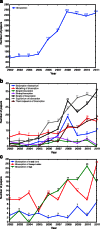State of the art for the biosorption process--a review
- PMID: 23666641
- PMCID: PMC3696181
- DOI: 10.1007/s12010-013-0269-0
State of the art for the biosorption process--a review
Abstract
In recent years, biosorption process has become an economic and eco-friendly alternative treatment technology in the water and wastewater industry. In this light, a number of biosorbents were developed and are successfully employed for treating various pollutants including metals, dyes, phenols, fluoride, and pharmaceuticals in solutions (aqueous/oil). However, still there are few technical barriers in the biosorption process that impede its commercialization and thus to overcome these problems there has been a steadily growing interest in this research field. This resulted in large numbers of publications and patents each year. This review reports the state of the art in biosorption research. In this review, we provide a compendium of know-how in laboratory methodology, mathematical modeling of equilibrium and kinetics, identification of the biosorption mechanism. Various mathematical models of biosorption were discussed: the process in packed-bed column arrangement, as well as by suspended biomass. Particular attention was paid to patents in biosorption and pilot-scale systems. In addition, we provided future aspects in biosorption research.
Figures







References
-
- Gadd GM. Journal of Chemical Technology & Biotechnology. 2009;84:13–28. doi: 10.1002/jctb.1999. - DOI
-
- Kuyucak N. Feasibility of biosorbents application. In: Volesky B, editor. Biosorption of heavy metals. Boca Raton: CRC Press; 1990. pp. 371–378.
-
- Kratochvil D, Volesky B. Water Research. 1998;32:2760–2768. doi: 10.1016/S0043-1354(98)00015-3. - DOI
Publication types
MeSH terms
Substances
LinkOut - more resources
Full Text Sources
Other Literature Sources

